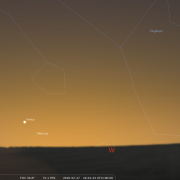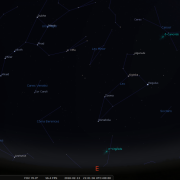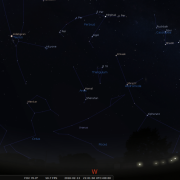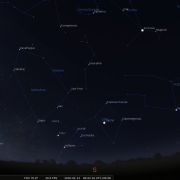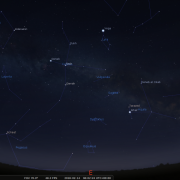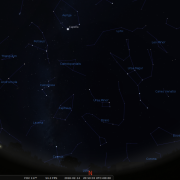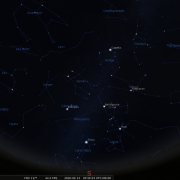✭✭✭ Happy Valentine's to All our Members ✭✭✭
A romantic issue? Mark's "Crossing the Line" series continues with 'The Heart-shaped Cluster' among other celestial delights.
Don't forget the Society Meeting on Tuesday 6th February 2018.
Welcome to the WDAS monthly newsletter for February 2018: a digest of the month's latest contributions to our website. Below you'll find Society News, Sky Notes and Crossing-the-Line, as well as coming events.
Society News
 As part of the Dark Skies festival held throughout February half term across North Yorkshire and beyond, our society will be hosting a ‘star party’ at the Danby Moors Centre on February 17th (Saturday).
As part of the Dark Skies festival held throughout February half term across North Yorkshire and beyond, our society will be hosting a ‘star party’ at the Danby Moors Centre on February 17th (Saturday).
If skies are clear we will be observing some of the jewels of the winter sky under very dark skies, the moon being just a few days old. The event is almost sold out; therefore scopes and transport are essential, so if you can make it along your assistance would be much appreciated.
The event runs from 19:00-21:00h, so we shall be setting off around 18:10h to allow time to set up equipment. Obviously it is February, and weather may dictate matters, suffice to say if it is not possible to observe outside, an indoor presentation will be given by Mark, and if dry the scaled solar system will be attempted. Hopefully snow will absent, but if conditions are hazardous i suspect the event will be cancelled. Talking of which...
RAF Fylingdales Event
The RAF Fylingdales event planned for January 18th, and organised by York A.S, the base, with assistance from us, had to be cancelled, victim of the wintry conditions. The forecast spell of snow duly arrived with around 6 inches covering the moors. Although the 18th itself was quite sunny, lying snow and plummeting evening temperatures would have made for hazardous surfaces on site as well as access roads. Base officers therefore called it off 24hrs earlier, giving time for everyone involved to get the message. It is hoped to reschedule the event for late February or sometime in March. I don’t know; snow in January, almost unheard of. We shall be seeing snow in February next! Anyone would think it’s winter!
Just to remind everyone subscription renewals are now underway for the coming year. Rates will be kept at 2017 levels, ie £12, with subsidised rates at £6.
You can bring subs along to the WDAS monthly meetings in December, January or February at the very latest. Mark will also doing the rounds sometime over the festive holidays, so no pretending to be out!
If you cannot make the meetings Cheques are made payable to;- Whitby & District Astronomical Society, Please address to Mark Dawson - 33 laburnum Grove, Whitby. YO21 1HZ.
Many thanks for your continued support.
There are just a few copies of night scenes 2018 remaining. If you would like a copy it’s just £4 to society members, £5.50 otherwise.
Sky Notes
In this month's Sky Notes:
Planetary Skylights
For much of February the dawn sky still hosts the majority of the naked eye planets, with Jupiter, Mars and Saturn all visible.

 Jupiter is the most conspicuous, a bright beacon (mag -2.1) due south around 06:00h. If you can get chance to observe, dawn is usually a better time to do so, simply because atmospheric interference is normally less than during the evening. Planetary detail is therefore easier to resolve and Jupiter is a particularly fine target for any size aperture. The disk always offers up plenty of interest (belts, banding, great red spot etc ) and the dance of the Galilean moon is fascinating to follow. The waning Moon passes nearby on the 8th.
Jupiter is the most conspicuous, a bright beacon (mag -2.1) due south around 06:00h. If you can get chance to observe, dawn is usually a better time to do so, simply because atmospheric interference is normally less than during the evening. Planetary detail is therefore easier to resolve and Jupiter is a particularly fine target for any size aperture. The disk always offers up plenty of interest (belts, banding, great red spot etc ) and the dance of the Galilean moon is fascinating to follow. The waning Moon passes nearby on the 8th.
 Trailing the ‘king of planets’ by some 10 degrees or so, look for the ochre hue of Mars (mag +1), which is of similar brightness and hue to nearby Antares; chief star in Scorpius, so the two should should not be mistaken. Antares is located between Mars and the horizon. Mars passes above Antares on the 10/11th.
Trailing the ‘king of planets’ by some 10 degrees or so, look for the ochre hue of Mars (mag +1), which is of similar brightness and hue to nearby Antares; chief star in Scorpius, so the two should should not be mistaken. Antares is located between Mars and the horizon. Mars passes above Antares on the 10/11th.
Telescopically Mars is still pretty small and featureless, but as we head towards the summer, and opposition its prominence will grow. The Moon lies nearby Mars and Antares on the 9th

 Further back in the SE and lower still, look for the pearly hue of Saturn (mag +0.5) above the SSE horizon. Telescopically, Saturn is a real tonic to the eye, and with the rings wide open, now is a good opportunity to try and spot any subtle detail on the disk. The moon lies nearby on the 11th.
Further back in the SE and lower still, look for the pearly hue of Saturn (mag +0.5) above the SSE horizon. Telescopically, Saturn is a real tonic to the eye, and with the rings wide open, now is a good opportunity to try and spot any subtle detail on the disk. The moon lies nearby on the 11th.
Then, between the 10th and 14th, look for Saturn emerging into the dawn sky, sliding up and right of Mercury. The two are closest on the 13th with Saturn just above Mercury. Good hunting.
 For the first half of February, there is little planetary interest in the evening sky, Neptune (which requires a scope anyway) is lost in twilight by midmonth, which just leaves Uranus (mag 5.7) residing low in the SW toward the bottom of the ‘V’ asterism in Pisces, not far above the star Torcularis Septentrionalis.
For the first half of February, there is little planetary interest in the evening sky, Neptune (which requires a scope anyway) is lost in twilight by midmonth, which just leaves Uranus (mag 5.7) residing low in the SW toward the bottom of the ‘V’ asterism in Pisces, not far above the star Torcularis Septentrionalis.
 After midmonth matters start to improve however, when first Venus and then Mercury pop into the evening twilight sky. Keep watch low to the WSW, where Venus will start to make its presence noticed. On the 16th a very slim waxing moon, just over 20 hrs old resides upper left of Venus, which is then only a few degrees above the horizon. Wait 25 minutes AFTER sunset and see if you can spot them.
After midmonth matters start to improve however, when first Venus and then Mercury pop into the evening twilight sky. Keep watch low to the WSW, where Venus will start to make its presence noticed. On the 16th a very slim waxing moon, just over 20 hrs old resides upper left of Venus, which is then only a few degrees above the horizon. Wait 25 minutes AFTER sunset and see if you can spot them.
By the last few days of February keep an even keener eye out for elusive Mercury which climbs up into the sky lower right of Venus, overtaking it and gaining altitude as we head into March. You will require a flat unobstructed view of the SW starting to observe approximately 30 minutes after sunset. More on Mercury next month.
Meteors

There is just one minor meteor shower this month, the Alpha Aurigids. The peak (if you can call it that) falls between Feb 6-9th. The Zenith Hourly Rate only reaches sporadic levels, barely half a dozen per hour, but if you do spot a meteor heading away from the direction of the zenith, (overhead) where the constellation of Auriga resides at this time of year, it is likely to be an Aurigid!
February 2018 Sky Charts
|
Looking North
Mid-February - 21:00h |
Looking South |
|
Looking East
Mid-February - 21:00h |
Looking West
Mid-February - 21:00h |
| Looking North (morning) Mid-February - 21:00h |
Looking South (morning) Mid-February - 21:00h |
| Looking East (morning) Mid-February - 06:00h |
Looking West (morning) Mid-February - 06:00h |
| Northern Aspect Mid-February - 06:00h |
Southern Aspect Mid-February - 06:00h |
Additional Image Credits:
- Planets and Comets where not otherwise mentioned: NASA
- Sky Charts: Stellarium Software
Events
 Observe the night sky with us at the Bruce Observatory, Whitby School
Observe the night sky with us at the Bruce Observatory, Whitby School
Observing Nights are held weather permitting: check for a relatively clear sky before leaving home. If in doubt, Mark can be reached on 07886069339
Please note the college drive gate is now operated via a electronic key code - so anyone wishing to attend must be at the car park at the top of the drive by 19:00hrs - unless an arrival time has been arranged with Mark/Keith.
 Whitby School - Room H1.
Whitby School - Room H1.
In Members' monthly meetings we usually take a tour of the night sky for the coming month using the Planetarium program. Have talks and presentations on various topics of astronomy/space etc, and discuss future events etc. New members welcome.
 Observe the night sky with us at the Bruce Observatory, Whitby School
Observe the night sky with us at the Bruce Observatory, Whitby School
Observing Nights are held weather permitting: check for a relatively clear sky before leaving home. If in doubt, Mark can be reached on 07886069339
Please note the college drive gate is now operated via a electronic key code - so anyone wishing to attend must be at the car park at the top of the drive by 19:00hrs - unless an arrival time has been arranged with Mark/Keith.
 Observe the night sky with us at the Bruce Observatory, Whitby School
Observe the night sky with us at the Bruce Observatory, Whitby School
Observing Nights are held weather permitting: check for a relatively clear sky before leaving home. If in doubt, Mark can be reached on 07886069339
Please note the college drive gate is now operated via a electronic key code - so anyone wishing to attend must be at the car park at the top of the drive by 19:00hrs - unless an arrival time has been arranged with Mark/Keith.
 Observe the night sky with us at the Bruce Observatory, Whitby School
Observe the night sky with us at the Bruce Observatory, Whitby School
Observing Nights are held weather permitting: check for a relatively clear sky before leaving home. If in doubt, Mark can be reached on 07886069339
Please note the college drive gate is now operated via a electronic key code - so anyone wishing to attend must be at the car park at the top of the drive by 19:00hrs - unless an arrival time has been arranged with Mark/Keith.
 Whitby School - Room H1.
Whitby School - Room H1.
In Members' monthly meetings we usually take a tour of the night sky for the coming month using the Planetarium program. Have talks and presentations on various topics of astronomy/space etc, and discuss future events etc. New members welcome.


